Uniden America UB317 SCANNING RECEIVER User Manual UB317Z BC350C 06 30
Uniden America Corporation SCANNING RECEIVER UB317Z BC350C 06 30
MANUAL
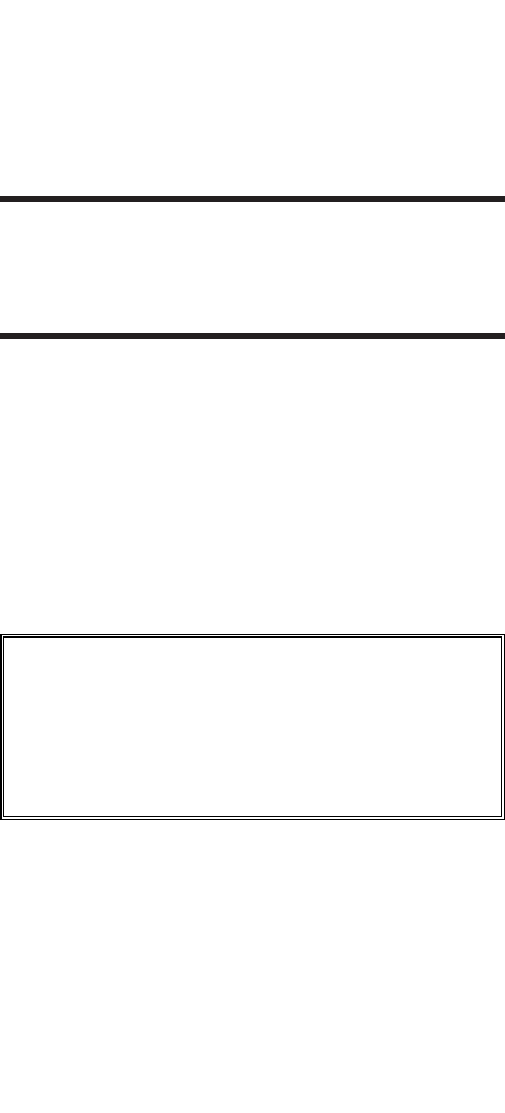
Precautions
Before you use thisscanner,
please observethe following:
WARNING!
Uniden America Corporationdoesnot representthis unitto be
waterproof.Toreducethe riskof fire, electricalshock, or
damageto the unit,do not exposethis unitto rainor moisture.
IMPORTANT!
The installation, possession, or use of this scanning radio in a
motor vehicle may be prohibited, regulated, or require a
permit in certain states, cities, and/ or local jurisdiction. Your
local law enforcement officials should be able to provide you
with information regarding the laws in your community.
Changes or modifications to this product not expressly
approved by Uniden, or operation of this product in any way
other than as detailed by this Operating Guide, could void
your authority to operate this product.
May be covered under one or more of the following U.S. patent:
4,627,100 4,841,302 4,888,815 4,932,074 4,947,456
5,014,348 5,199,109 5,408,692 5,428,826 5,438,688
5,448,256 5,465,402 5,471,660 5,483,684 5,530,296
5,548,832 5,551,071 5,574,995 5,577,076 5,598,430
5,600,223 5,642,424 5,710,992 5,896,422 5,991,346
5,991,603 6,012,158 6,025,758 6,034,573 6,064,270
6,266,521
** U.S. Patent Number 4,841,302 is licensed from Gray Electronics, Inc.
** These products contain Uniden proprietary information. Software, control
codes, protocols and other such related matter may be the copyrighted work of
Uniden America Corporation.
© Copyright 2002-2003, Uniden America Corporation. All Rights Reserved.
© 2003 Uniden. This product contains Uniden proprietary information.
Software, control codes, protocols and other such related matter may be the
copyrighted work of Uniden America Corporation.
Printed in China
Uniden ® is a registered trademark of Uniden America Corporation.
Bearcat ® is a registered trademark of Uniden America Corporation.

Table of Contents
About Your New BC350C ......................................................1
What is Scanning? ................................................................2
Types of Communication....................................................2
What is Searching?................................................................3
What is Trunk Tracking? ......................................................4
Where to Obtain More Information ......................................5
Information on the Internet ................................................5
Included with Your Scanner Package ..................................6
Optional Accessories..........................................................6
Summary of Features ............................................................7
Installing the BC350C ............................................................8
For Home Use (Desktop Installation) ................................8
For Mobile Use (In-Car Installation) ..................................8
Controls and Functions ......................................................10
Screens ............................................................................15
Scanning Overview ..............................................................17
Getting Started ................................................................17
Turn the Scanner On........................................................17
Adjusting the Squelch ......................................................18
Scanning ..............................................................................19
Weather Channel Scan ....................................................19
Channel Lock Out ............................................................20
Band Search ........................................................................22
Displaying the band range ..............................................22
Programming Frequencies..................................................24
Programming from SCAN mode ......................................25
Programming from SEARCH mode..................................26
Deleting a programmed frequency
(programming "000.0000") ............................................27
To find "000.0000" in Search Band 50 – 54: ....................28
Program Lock Feature......................................................28
Helpful Hints ........................................................................29
Troubleshooting ..................................................................30
Technical Specifications ....................................................31
One Year Limited Warranty ................................................33

1
About Your New BC350C
The BC350C is not just a scanner. It is a brand new informa-
tion radio with automatic scanning capabilities. The built-in
Service Scan system brings you instantly into the exciting
world of scanning action. Best of all, you don’t even have to
program the scanner to begin using it!
The BC350C comes with six Service banks for monitoring
police, fire/emergency medical services, marine, air, weather,
and CB frequencies. Not only that, there’s even a fully pro-
grammable bank for storing your own private collection of
favorite frequencies.
With the BC350C, you can scan over 3,600 channels. In addi-
tion, the BC350C has 13 separate band search capabilities for
even greater scanning action.
Two Service Scan banks, POLICE and FIRE/EMS also have
programmable. Channels to store additional police and
Fire/EMS frequencies.
So whenever you encounter a newly activated local frequency
for either service category, you can add it to the bank for that
category. This gives you quick access to the frequencies you
want to hear.
So enjoy your BC350C!

2
What is Scanning?
Unlike standard AM or FM radio stations, most two-way com-
munications (listed below) do not transmit continuously. The
BC350C scans programmed channels at the rate of up to 100
channels per second until it locates an active frequency.
When scanning stops on an active frequency, it remains on
that channel as long as the transmission continues. When the
transmission ends, the scanner stays on the channel for 2
more seconds, waiting for another transmission. If no
response is detected, the scanning cycle resumes until anoth-
er transmission is received.
Types of Communication
You will be able to monitor communication such as:
•Police and fire departments (including rescue and para-
medics)
• NOAA weather broadcasts (8 pre-programmed channels)
•Citizens Band (CB)
•Business/industrial radio
•Motion picture and press relay
•Utility
•Land transportation frequencies, such as trucking firms,
buses, taxis, tow trucks, and railroads
•Marine and amateur (ham radio) bands
•Air band
•And many more in the 25-54 MHz, 108-174 MHz, and 406-
512, and 806-956∗MHz ranges
∗Excluding Cellular Telephone Band
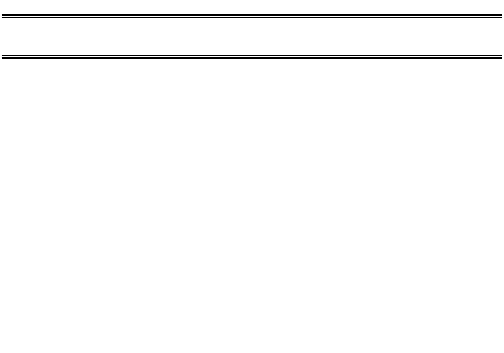
3
What is Searching?
The BC350C can search each of its 13 bands to find active
frequencies. This is different from scanning because you are
searching for frequencies that have not been programmed
into your Scanner’s channels. The scanner automatically
chooses between two speeds (Search and Turbo Search)
while searching. During Search Mode the scanner will search
100 frequencies per second, while in Turbo Search Mode the
scanner can achieve up to 300 frequencies per second in the
VHF FM band.

4
What is Trunk Tracking?
Conventional scanning is a simple concept. You enter a radio
frequency in your scanner’s memory which is used by some-
one you want to monitor. For example, the police in your area
may broadcast on 460.500 MHz, the fire department on
154.445 MHz, the highway department on 37.900 MHz, etc.
So when your scanner stops on a frequency, you usually
know who it is, and more importantly, you can stop on a chan-
nel and listen to an entire conversation. This type of scanning
is easy and fun.
As the demand for public communications has increased,
many public radio users don't have enough frequencies to
meet their needs, and this has created a serious problem.
Trunking radio systems have been implemented to.
In a trunked radio system the frequencies are shared among
the police and fire departments and a computer systematically
assigns available frequencies when they are needed for com-
munications.
Sharing of the available public service frequencies, or trunk-
ing, allows cities, counties, or other agencies to accommodate
hundreds of users with relatively few frequencies. Following a
conversation on a trunked system using a scanner is difficult,
if not impossible. Because when there's a short break during
the conversation you're monitoring, talkgroup will be assigned
to a completely different frequency in the trunked system.
If your local police, FIre and EMS agencies use a trunked sys-
tem and you want to be able to follow their communications,
you will want to purchase one of Unidens Trunk Trading
Scanners.

5
Where to Obtain More Information
Before you can scan the PRIVATE bank, you must program
the Police, Fire, EMS frequencies into the scanners channels.
The Frequency Guide lists typical frequencies used around
the U.S.A. and Canada that you may program into your new
scanner. However, this is not a complete list of frequencies for
your area.
To obtain frequency information for your area, contact one of
the following:
•Scanner Master
1 (800) Scanner (7226634) (Hours are from 10:00 a.m. to
5:00 p.m. Eastern Time Monday through Friday.)
frequenciew@scannermaster.co
To obtain another copy of the frequency guide, contact one
of the following:
•Uniden Parts Department
(800) 554-3988 (Hours are from 7:00 a.m. to 5:00 p.m.
Central Time Monday through Friday.)
•Local Dealer
Information on the Internet
If you have access to the internet, you may want to visit one
of the following websites for additional information:
scanner.uniden.com
www.scannermaster.com

6
Included with Your Scanner
Package
•BC350C Auto Scanner
•Telescoping Antenna (Model AT-124)
•Fixable Mobile Antenna (ANT-002)
•AC Adapter (Model AD-140U)
•Cigarette Lighter Adapter Plug (CO-007)
•This Operating Guide
•Registration Form
•Frequency Guide
•Other Printed Materials
If any of these items are missing or damaged, immediately
contact your place of purchase or Uniden Customer Hotline
at: 8:00 a.m. to 5:00 p.m., Central Time, Monday through
Friday.
Optional Accessories
The following optional accessories for your BC350C are avail-
able from your local Uniden Dealer or through the Uniden
Parts Department by calling: (800) 554-3988, 8:00 AM to 5:00
PM CST, Monday through Friday. We can also be reached on
the web at www.uniden.com.
Mobile Mounting Bracket (Model MB-007) – For mobile use
(In-car Installation), use it to install the BC350C in your car.
DC Power Cord (Model PS-001) – For Hard wiring power
from your car to your scanner.
Motorola Antenna Adapter (Model PLG-134) – Use only if
your antenna has a Motorola type plug.

7
Summary of Features
The BC350C is a compact mobile/base scanner, and one of
the most user friendly communication products available today.
The BC350C features:
•Turbo search – Allows your BC350C to scan and search
300 channels or STEPS per second.
•Seven Banks – Six pre-programmed Service banks and one
standard, programmable Private bank. These banks include:
POLICE: 739 Factory programmed Police frequencies
with 30 open channels allowing you to program
additional Police frequency int this bank.
FIRE/EMS: 197 Factory Programmed Fire/EMS
frequencies plus an additional 20 Open
Channels for you to program local Fire/EMS
frequencies into this bank.
AIR: 1,160 Factory programmed frequencies which
covers the complete AIR band, 108.000 to
136.975MHz.
MRN: 90 factory programmed frequencies which
cover the complete Marine band.
WX: 7 Factory programmed frequencies covering all
NOAA Weather Service Broadcasts.
CB: XXX Factory programmed frequencies covering
the CB communications.
PRIVATE: 50-channel, fully user-programmable bank.
•13 Search Bands – Use the [BAND] key to select a band
to search.
Band Frequency Coverage Steps Service
25 – 28 25.0000 to 27.9950 MHz 5 kHz CB/Business
28 – 30 28.0000 to 29.7000 MHz 5 kHz 10 Meter AAM
30 – 50 30.0000 to 49.9950 MHz 5 kHz VAF Low Band
50 – 54 50.0000 to 54.0000 MHz 5 kHz 6 Meter HAM
108 – 137 108.0000 to 136.9875 MHz 12.5 kHz AirCraft Band
137 – 144 137.0000 to 143.9950 MHz 5 kHz Military
144 – 148 144.0000 to 147.9950 MHz 5 kHz 2 Meter HAM
148 – 174 148.0000 to 174.0000 MHz 5 kHz VAF Hight Band
406 – 420 406.0000 to 419.9875 MHz 12.5 kHz
Federal Government
420 – 450 420.0000 to 449.9875 MHz 12.5 kHz 70 cm HAM
450 – 470 450.0000 to 469.9875 MHz 12.5 kHz UHF Band
470 – 512 470.0000 to 512.0000 MHz 12.5 kHz UHF TV Band
806 – 956 806.0000 to 823.9875 MHz 12.5 kHz "800" Band
∗
849.0125 to 868.9875 MHz
894.0125 to 956.0000 MHz
∗
Excluding cellular telephone band

8
Installing the BC350C
For Home Use (Desktop Installation)
1. Insert the DC plug end of the AC Adapter into the DC
13.8V jack on the rear panel.
2. Plug the AC Adapter into a standard 120V AC wall outlet.
Warning: Do not plug the AC Adapter into an outlet con-
trolled by a wall switch. This could cause scanner memory
loss.
3. Plug the Telescoping Antenna into the ANT connector.
Extend the antenna to its full height. For frequencies higher
than 406 MHz, shortening the antenna may improve the
reception.
4. Use the desktop stand for a better viewing and operating
angle.
Helpful Hints
•If strong interference or electrical noise is received, relocate
the scanner or its antenna away from the source.
•If you are operating the scanner in a fringe area or need to
improve reception, use an optional antenna designed for
multi-band coverage. (You can purchase this type of anten-
na at a local electronics store.)
•If the optional antenna has no cable, use 50-70 ohm coaxial
cable for lead-in. A mating plug may be necessary for the
optional antennas.
For Mobile Use (In-Car Installation)
Mounting the Radio for every day use
Installation for Temporary Use:
A Cigarette Lighter Power Cord is provided for easy, tempo-
rary installation.
Warning: Do not use the cigarette lighter power cord in a
positive ground vehicle.
Plug one end of the Cigarette Lighter Power Cord into the cig-
arette lighter jack and the other end into the DC 13.8V jack on
the back of the scanner.

9
Connecting the Antenna Plug
Connect the mobile antenna plug into the ANT connector on
the rear panel. (For more information on antenna installation,
please refer to the instruction guide that came with your
antenna.)
The BC350C can be mounted using the mounting bracket
(optional).
This bracket is available from the Uniden parts department
(see page 3)
1. Select an ideal location in your vehicle to mount the
BC350C. Avoid a location that could interfere with your
driving. In a passenger car, the ideal location is underneath
the dashboard on the passenger side.
2. Use the mounting bracket (optional) as a template for
marking the location of the mounting screws. Note: If there
are screws already holding the dashboard, you can use the
same screw holes to mount the bracket.
3. Drill the necessary holes and secure the mounting bracket
in place using the screws provided.
4. Mount the radio to the bracket only after the wiring has
been connected to the rear panel.
Connecting the Power Cord
Note: If you are not experienced in connecting accessories to
the vehicle fuse box, please see your automotive dealer for
advice on proper installation.
Installation for everyday use:
1. Check the vehicle battery connections to determine which
battery terminal (positive or negative) is grounded to the
engine block or chassis. Most of today’s vehicles use a
negative ground. If your vehicle has a negative ground, fol-
low Steps 2 and 3. Otherwise, skip to the note following
Step 3.
2. Connect the RED wire of the DC power cord to the acces-
sory contact in your vehicle’s +13.8 VDC fuse box.
3. Connect the BLACK wire of the DC power cord to the neg-
ative side of the vehicle (usually the chassis).
Note: In vehicles with a positive ground, the RED wire con-
nects to the chassis and the BLACK wire connects to the
accessory contact in the fuse box.
4. Insert the DC plug into the DC 13.8V jack on the back of
the scanner.
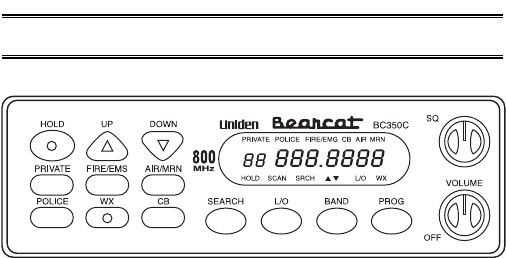
10
Controls and Functions
[HOLD] KEY Press [HOLD] to stop scanning or
searching. Press any bank key, [UP],
or [SEARCH] to deactivate Hold
Mode. In the Hold Mode, [UP] and
[DOWN] are active.
[UP] & [DOWN] KEYS These keys are used in several
different ways:
To manually step up or down a
frequency/channel in any Hold Mode,
use [UP] or [DOWN].
Frequency/channel steps are all
preset for each band (see Technical
Specifications).
To change the direction of the search
during Search Mode, press [UP] to
search upward to a higher frequency,
or [DOWN] to search downward to a
lower frequency.
To rapidly search or scan
frequencies/channels upwards or
downwards, press [UP] or [DOWN]
for more than one second. To stop
the search/scan, release the [HOLD]
key.
[PRIVATE] KEY Use [PRIVATE] to instantly access
your private collection of favorite
frequencies. You can program up to
50 channels in the PRIVATE bank.
There are no pre-programmed
frequencies in this bank. After
Front Panel
11
programming, press [PRIVATE] to
activate PRIVATE scan. In the
PRIVATE Scan Mode, press [HOLD]
to stop scanning.
Then use [UP] or [DOWN] to step
through all 50 channels manually
(including Locked Out channels).
[FIRE/EMS] KEY Press [FIRE/EMS] to start scanning
fire and emergency medical
frequencies. The FIRE/EMS bank
already has 197 pre-programmed
frequencies.
They are used for fire department
and emergency medical
communications.
Because new frequencies may be
activated in your local area, 20 extra
open channels in this bank have
been provided for programming
additional frequencies. (See the
programming procedures for
programming new frequencies into
this bank.)
[AIR/MRN] KEY The AIR band bank key is fully
pre-programmed (108.000 to 136.975
MHz). Press [AIR/MRN] to start
searching through all 1,160
frequency steps of the AIR band.
All 90 marine channels are
programmed into the Marine (MRN)
bank. Press [AIR/MRN] twice to start
scanning marine channels.
[POLICE] KEY Press [POLICE] to start scanning
police frequencies.
The POLICE bank contains over 700
known frequencies used by the
police, including state troopers, local
police and sheriff, etc. For new
frequencies, 30 more channels in this
bank have been provided for you to
program. (See the programming
procedures for storing new
frequencies into this bank.)

12
[WX] KEY Seven NOAA frequencies are
programmed into the Weather (WX)
bank. Press [WX] to find your local
weather channel.
[CB] KEY XXCB channels are programmed into
the CB bank. Press [CB] to start
scanning CB channels.
[SEARCH] KEY Press [SEARCH] to start searching
active frequencies within the band
previously selected with the [BAND]
key. Normally, the search continues
from the frequency where it left off in
the previous search. In Search Mode,
(after pressing [SEARCH]), the
[BAND] key becomes active.
Use [BAND] to select the band you
wish to search. When selecting a
band to search, release the key and
the scanner will automatically start
searching upward from the lowest
frequency of its band. (The symbol
appears next to "SRCH" on the
display.) To search from a higher
frequency to a lower frequency, press
[DOWN]. (The symbol is now
displayed next to "SRCH".
[L/O] KEY Press [L/O] to "lock out" or prevent
scanning of the displayed frequency.
[L/O] is active only during opened
squelch or in the Hold Mode.
Locked out channels can be
displayed on the screen by using the
[UP] or [DOWN] key to manually
scan through the selected bank in
Hold Mode only. "L/O" appears on
the display to indicate that the
channel is locked out. Note: Locking
out a channel will not erase the
programmed frequency.
[BAND] KEY This key is active in Search Mode
only (when "SRCH" is displayed on
the screen). When you press
[BAND], the upper and lower limits of
the band you are searching are
displayed for 3 seconds. Then the

13
display returns to the current
frequency. Press [BAND] again
within 3 seconds to step up one
higher band. Press this key as many
times as it takes to find the band you
want to search.
Important: This key has a very
important secondary function.
In Program Mode, you can press
[BAND] to leave this mode.
[PROG] KEY This key initiates and completes
programming. It is active whenever a
steady frequency appears on the
display. Press [PROG] to start
Programming Mode. "CH" appears
and blinks, indicating you are in
Programming Mode, and urges you
to select the channel of the bank to
be programmed. Press a
programmable bank key ([PRIVATE],
[FIRE/EMS] or [POLICE]) to be
programmed. Note: Never press
non-programmable bank keys ([WX],
[AIR], [CB], or [MRN]). If you press
one of these keys, "Error" will be
displayed, and you may lose the
frequency you wanted to program.
VOLUME Control/ This control turns the scanner on or
Power Switch off, and also adjusts the volume.
SQ (Squelch) Control Adjust [SQ] to set the scan threshold.
When you are monitoring a single
channel in Manual Mode, adjust [SQ]
to eliminate the background noise
heard in the absence of an incoming
signal.
LCD Display The liquid crystal display (LCD)
shows the current channel or its
frequency. It also displays the mode
indicators, status indicators, and
bank indicators. (See the Screens
section for more information.)
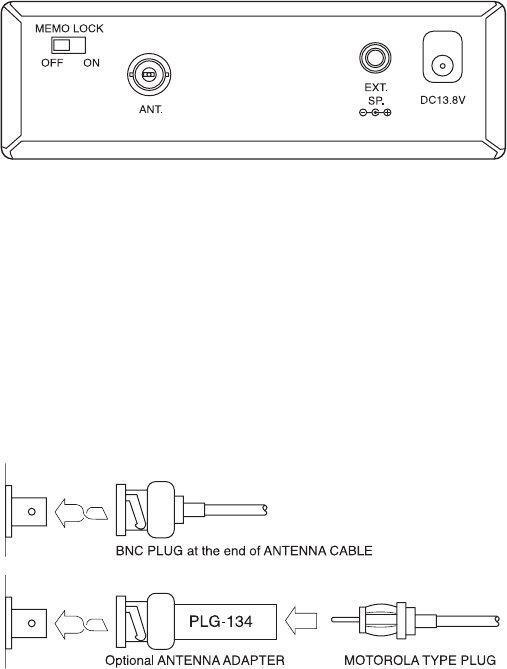
14
MEMO LOCK Switch In the ON position, the Program
([PROG]) key is disabled. This
prevents any unauthorized
programming or accidental entries.
When programming is disabled,
pressing [PROG] emits an error entry
tone and displays "PRG-Loc".
ANT.
(Antenna) Connector
Rear Panel
Connect your Antenna plug here.
If you have a Motorola-type plug, use
the optional adapter (PLG 134).
EXT. SP. When using an optional External
(External Speaker) Speaker system, connect the
Connector External Speaker plug here.
DC 13.8V Connect the DC power cable here.
Power Connector Note: Use only the specified AC
Adapter or DC power cord.
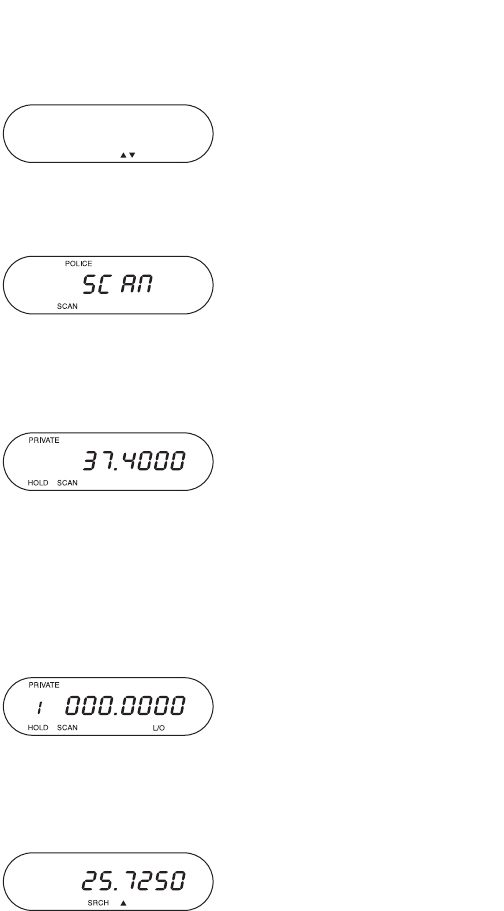
15
Screens
The following illustrates some of the screen displays you will
use:
The digits and words on the
screen at the left are shown for
reference only. They do not all
display at the same time.
SCAN Screen
"SCAN" scrolls through the
display right to left. The display
shows scanning the POLICE
bank.
SCAN, HOLD Screen
(in PRIVATE bank)
This screen displays the channel
number and frequency the
scanner has stopped on. The
[HOLD] button has also been
pressed. When scanning stops on
an active frequency, the display
will look like this screen, but
without "HOLD" showing.
Open Channel Screen
If you press the [PRIVATE] key
without programming the bank,
you will see the screen a left.
"L/O" is displayed for all open
channels.
Search Screen
When Search stops on a
frequency, you will see display
like that shown at the left. ▲
indicates upward search, and ▼
downward search.
PRIVATE
HOLD SCAN SRCH L/O WX
POLICE FIRE/EMS CB AIR MRN
88 888.8888
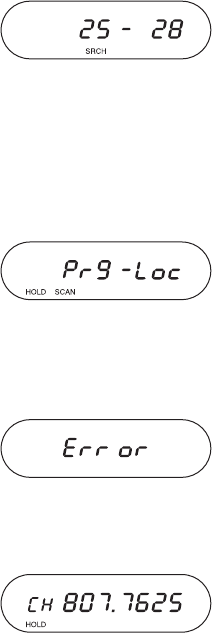
16
Band Screen
When pressing [BAND] in the
Search Mode, the band you are
currently searching appears on
the display. Press [BAND] again
within 3 seconds to change to
another band. This display
changes automatically to the
Search screen.
Programming Lock Screen
When you see this screen, you
will not be able to program any
frequencies into your scanner.
Press any bank key or [SEARCH]
to erase this display.
Programming Error Screen
When you try to program a
frequency into any of the
non-programmable banks,
"Error" appears on the display.
Programming Mode Screen
When you enter the Programming
Mode, "CH" blinks next to the
frequency on the display. You can
now select a bank place the
frequency in.

17
Scanning Overview
You can scan in one of three ways:
1. Service Bank Scanning Press one of the six service bank
keys, [POLICE], [FIRE/EMS], [AIR], [WX], [CB], or [MRN],
to find an active frequency.
2. Band Search Select a frequency band to search. The
Search function is different from scanning. It searches for
any active frequency step by step within the lower and
upper limits of the band. When an active frequency is
found, the scanner will stop and stay on that frequency as
long as that transmission lasts. If that frequency is
interesting to you, press [HOLD] to hold the frequency in
the display. Then program it into one of the programmable
banks (PRIVATE, POLICE or FIRE/EMS). If you do not
want to program that frequency, press [SEARCH] or just
wait till the transmission ends. The search resumes
automatically 2 seconds after the last transmission and
looks for more active frequencies.
3. PRIVATE Bank Scanning If you have programmed
frequencies into this bank, press [PRIVATE] to scan only
those that you have programmed in this bank.
Note: Before you can scan the PRIVATE Bank, you must
program frequencies into the channels. To program
frequencies, see "Programming Frequencies" on page xx.
When scanning stops on an active frequency, it remains on
that channel as long as the transmission continues. When the
transmission ends, the scanner will remain on the same
channel for 2 more seconds, waiting for a responding
transmission. If there is no responding transmission within
2 seconds, the scanning cycle resumes.
Getting Started
The following instructions apply when using your BC350C for
the very first time. Each time you turn on the scanner, it
always retains the previous settings in its memory. That is, the
scanner operates in the mode and bank last used, until you
change the settings.
1. Turn the Squelch [SQ] Control fully clockwise to the end.
2. Power on the scanner by turning [VOLUME] clockwise.
Adjust the volume to where you can hear a steady noise.

18
3. Set the squelch at the scanning threshold by turning [SQ]
counterclockwise just until the noise disappears.
4. Press any of the Service bank keys: [POLICE],
[FIRE/EMS], [AIR], [WX], [CB], or [MRN]. The scanner
automatically starts scanning the selected bank.
Note: Later, when you have learned how to program chan-
nels in the PRIVATE bank, you can press [PRIVATE] to
scan your favorite collections.
5. Adjust the volume to a comfortable listening level.
Adjusting the Squelch
1. Open the squelch by turning [SQ] clockwise to the end.
You should hear a steady sound (scanning stops).
2. Turn [SQ] counterclockwise slowly until the sound disap-
pears. This is the threshold point at which scanning starts.
At the squelch threshold, an incoming signal just slightly
stronger than the noise will open the squelch.
Note: When squelch is open, you can hear the voice
(scanning is stopped). If squelch is set too tight, that is, too
far counterclockwise from the threshold point, a stronger
signal is required to open the squelch.
If squelch is set on a point clockwise from the threshold,
you will hear a constant sound (noise, if no signal is pres-
ent). The scanner will not scan.

19
Scanning
To start scanning, press any bank key.
When the BC350C is scanning, you can see the "SCAN"
message moving across the display. Scanning stops on any
active channel automatically and displays its frequency,
except those channels programmed with L/O (Lock Out).
Scanning resumes when you press the bank key or [UP] key.
To stop scanning at any time, press [HOLD]. When you press
[HOLD], you are in the Scan/Hold Mode. The scanner
remains on the displayed channel until you press the bank
key or [UP] key again to resume scanning. (Or, you can press
[SEARCH] to start searching.)
In the Scan/Hold Mode, each time you press [UP] or
[DOWN], you step up or down one channel at a time (one
frequency step each for the AIR or WX bank). To rapidly step
through that bank, press and hold [UP] or [DOWN] key. In the
Scan/Hold mode, you do not skip a locked out (L/O) channel
using [UP] or [DOWN].
While scanning and the scanner stops on an active channel
that you do not want to monitor, but you do not want to lock
out, you can simply press the bank key [PRIVATE],
[POLICE], [FIRE/EMS], [CB] again or the [UP] or [DOWN]
keys.
Note: To resume scanning while in the Marine or Aircraft
mode, you can only press the up and down keys. Pressing
the bank key again will switch you from Marine to Air or Air to
Marine.
Note: Before you can scan the PRIVATE bank, you must
program the channels.
Weather Channel Scan
The BC350C allows you to search for your local NOAA
weather channel.
Press [WX] to find the active weather channel in your area
from 7 pre-programmed NOAA channels. To exit Weather
Mode, press any other bank key or [SEARCH].
It is possible that your area is covered by more than one
weather station.
When you press [WX], the BC350C will find an active broad-
cast immediately. If the broadcast sounds weak and distant,
press [WX] again to look for a closer station.

20
Channel Lock Out
•If the scanner beeps stopping on a particular channel due to
noise or frequent un-wanted transmissions, you may want
to keep that channel from being scanned. Usin the channel
Lock out feature will skip this channel during scanning.This
do not erase the frequency from the chanel.
•For PRIVATE bank, you can lock out all the channels in a
bank, if desired. However, if you do, pressing that bank key
will emit an error tone and the scanner will not scan.
•In the POLICE bank, MRN bank, CB bank, or FIRE/EMS
bank, you can lock out 20, 30, 40 or ALL factory pre-
programmed channels (those frequencies that display
without channel numbers in Scan Mode). This enables you
to make a secondary private bank, if desired.
•You cannot lock out any frequency in the WX or AIR banks.
These banks are frequency search banks, and you cannot
lock out any frequency in Search Mode.
•[L/O] is active only when squelch is opened (scan is
stopped) or in Hold Mode.
Locking Out an Unwanted Channel
In Scan Mode, press [L/O] when the scanner stops on a
channel you do not want to hear. The scanner locks out that
channel and immediately advances to the next channel to
resume scanning.
In Scan/Hold Mode, press [L/O] to lock out the displayed
channel/frequency. In this case pressing [L/O] will not
advance to the next channel. "L/O" will appear on the screen
to indicate that the displayed channel is locked out.
Note: All weather channels transmit continuous broadcasts.
Once the Weather scan stops on a transmission, it will remain
on that channel. Weather scan will not resume automatically.
You must press [WX] again to reactivate scanning. In some
parts of the country, you may not be able to monitor weather
broadcasts, such as in low-lying areas. Normally a higher
location will improve the reception.
Note: It is not recommended to program a weather frequency
into any banks. Because weather channels transmit continu-
ously, the scanner will stop on that channel, disrupting the
scanning cycle. The Weather Scan feature was provided
specifically to avoid this occurrence.
21
Searching for Locked Out Channels
In Scan Mode, you will not see locked out channels. However,
to search for locked out channels and display them on the
screen, use [UP] and [DOWN]. These keys will enable you to
search manually through the bank in Hold Mode only. "L/O"
will appear on the screen to indicate the locked out channel.
Restoring a Locked Out Channel
Suppose you want to unlock Channel 12 of the PRIVATE
bank. Press [PRIVATE] to start scanning. Press [HOLD] to
stop scanning. ("HOLD" & "SCAN" must appear on the
screen.) Use [UP] or [DOWN] to find locked out Channel 12
(which shows "L/O"). Then press [L/O]. "L/O" disappears to
indicate that Channel 12 is now unlocked and restored for
scanning.
Note: For the factory pre-programmed channels, the earliest
channel will be unlocked, when you lock out more than 20,
30, 40 or all channels.
Restoring All Locked Out Channels
1. You can unlock all locked out channels in any bank at one
time. Press a bank key to start scanning.
2. Press [HOLD] to stop scanning.
3. Press and hold down [L/O] ("L/O" appears on the screen)
for more than 2.5 seconds until you hear the multi-beep
("L/O" disappears).
Now all locked out channels in the bank are unlocked and
restored for scanning.
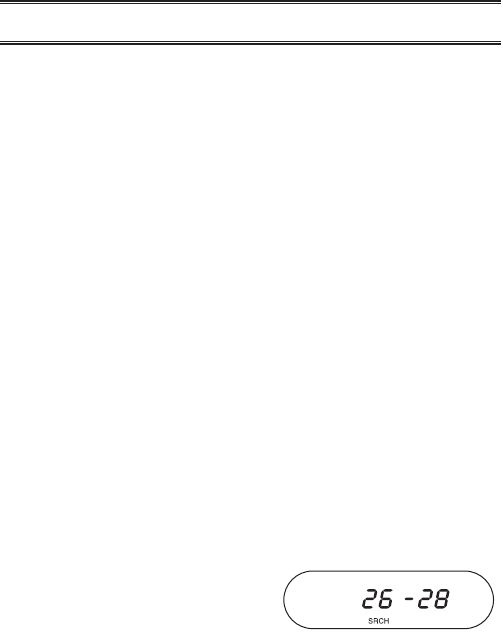
22
Band Search
The BC350C can search up to 13 separate frequency bands
to help you discover new and exciting frequencies in your
area.
To start scanning, press [SEARCH].
Searching starts from the frequency most recently used.
Press [UP] or [DOWN] to change the searching direction.
Searching stops on any active frequency automatically and
displays its frequency. When the conversation stops on the
active frequency, the scanner will resume searching for
another active channel.
If you want to monitor a specific conversation, press [HOLD]
to place the scanner in [HOLD] mode. The scanner will
remain on the frequency displayed until you press [SEARCH]
or [BAND] to resume scanning.
In the [HOLD] mode, each time you press [DOWN] or [UP],
you step up or down one frequency at a time. To rapidly step
through frequencies press and hold the [DOWN] or [UP] /
[SEARCH].
Displaying the band range
To display the frequency band
range, press [BAND] during
search mode. Each time you
press [DOWN] or [UP] / [BAND],
you step up or down one band range at a time. Searching
begins automatically 3 seconds after the band range is
displayed (or you can press [SEARCH] to start searching).
Frequency Lockout
If the scanner keeps stopping on a particular channel due to
noise or too frequent transmissions, you may want to lockout
or skip that frequency while searching.
To skip over a frequency, wait until the scanner stops at that
frequency. Then press the [L/O] lockout key. The scanner
immediately resumes scanning because the locked out
channel is no longer in the searching sequence.
Note: You can program up to 40 L/O frequencies. The 41st
L/O frequency entered causes the 1st locked out frequency to
become unlocked.
23
To restore one locked out frequency, place the scanner in the
[HOLD] mode, use [UP] or [DOWN] to find the locked out
frequency. Then press [L/O] to unlock the frequency and
place it back in the search rotation. To restore all locked out
frequencies within a bank, press and hold [L/O] key for more
than 2 seconds while in the [HOLD] mode.

24
Programming Frequencies
For POLICE, FIRE/EMS, or PRIVATE bank, you can program
one frequency per channel. Store your favorite frequencies
into the channels of each bank, one frequency per channel.
•You can program any displayed frequency on the screen.
•If you do not know any local you can search for an active
frequency by scanning any service bank or searching any
selected band. Then, when you find a desired frequency,
program that frequency to the bank.
•You can also program a non-active frequency. If you known
a local frequency, press [SEARCH]. Then press [BAND] to
select the band which covers that frequency. When the
search is near the frequency you want displayed on the
screen, press [HOLD] to stop searching. Then use [UP] or
[DOWN] to display the frequency you want to program.
•You cannot program a frequency into AIR, MRN, CB, or
WX.
Note: It is recommended that you do not program a Weather
frequency into the PRIVATE bank.
Note: In order to program the Private Channels in your
scanner you must obtain the frequencies of the agencies
(Police, Fire, EMS, etc.) you want to monitor. Information on
how to obtain these frequencies can be found "where to
obtain more information" on page xx.

25
Programming from SCAN mode
For example, when you find an interesting active police
frequency while scanning, and want to program it into your
private bank (see "SCANNING" on page xx) to scan the bank:
1. Press [HOLD].
HOLD appears on the display.
2. Press [PROG]. CH appears
and blinks to indicate that you
are in the Programming Mode.
To change the displayed fre-
quency, use [UP] or [DOWN]
while CH is blinking.
3. Press [PRIVATE]. PRIVATE
appears on the display.
If you want to program it into
another bank, press the
desired bank key. The bank
name appears on the display.
2 screens alternate to indicate
that Channel 1 is available to
be programmed.
The scanner automatically
selects the lowest open
channel (000.0000) for easy
programming. If all channels
have been programmed (there
are no open channels in the
bank), channel 1 appears.
Use the [UP] or [DOWN] keys
to select a new channel and
even over write old channels.
4. Press [PROG] to store the
frequency in the desired
channel.
Note: Press [BAND] to escape
from programming mode before
step 4.

26
Programming from SEARCH mode.
For example, when you find an interesting active police fre-
quency while searching 144 - 148 band, and want to program
it into POLICE bank (see "Band Search" on page xx to search
a frequency).
1. Press [HOLD]. HOLD icon
appears in the display.
2. Press [PROG]. CH appears
and blinking to indicate that
you are in the programming
mode.
3. Press [POLICE]. POLICE icon
appears in the display.
If you want to program it into
another bank, press the
desired bank key. The bank
name appear on the display.
2 screens alternate to indicate
that channel 1 is available to
be programmed.
The scanner automatically
selects the lowest open
channel (000.0000) for easy
programming. If all channels
have been programmed (there
are no open channels in the
bank), channel 1 appears.
Use the [UP] or [DOWN] keys
to select a new channel and
even over write old channels.
4. Press [PROG] to store the
frequency in the desired
channel.
Note: Press [BAND] to escape
from programming mode before
step 4.
27
Deleting a programmed frequency
(programming "000.0000")
You can erase a programmed frequency in a channel by
programming "000.0000" into its channel. You can find and
display "000.0000" on the screen in one of two ways:
Find an open channel in the private bank. Press the desired
bank key (PRIVATE, POLICE, or FIRE/EMS) then [HOLD],
and use [UP] and [DOWN] to scroll through the bank to find
an open channel, "000.0000"
– OR –
Find "000.0000" from the Search & Program Mode. Every
search band has one "000.0000" display included between
the band limits. It can be displayed only in the Program Mode
(after pressing [PROG] and "CH" is blinking in the display).
Note: Press [BAND] to escape from programming mode
before step 4.
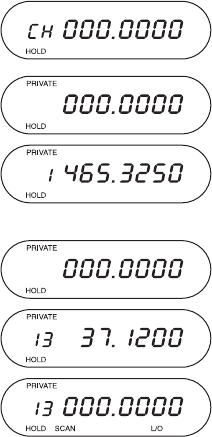
28
To find "000.0000" in any Search Band
1. Select Search Band 50 - 54 by pressing [BAND] in the
Search ode, for example band 50-54.
2. Press [HOLD] to stop searching.
3. Press [PROG] to go into Program Mode.
4. Use [UP] and [DOWN] to display "50.0000" or "54.0000".
5. Press [DOWN] one time at the "50.0000" screen to display
"000.0000"
– OR –
For example to erase a programmed frequency in channel 13
of the PRIVATE BANK:
Program Lock Feature
The BC350C has a program lock feature [Memory Lock] to
prevent accidental programming entries or unauthorized pro-
gramming. Simply turn on the MEMO LOCK switch on the
rear panel to disable [PROG] and protect your programmed
frequencies in memory.
1. Find this screen in the
programming Mode.
2. Press [PRIVATE]. PRIVATE
appears in the display.
2 screens alternate to indicate
that Channel 1 is ready to be
programmed.
3. Use [UP] or [DOWN] to select
Channel 13.
Now, Channel 13 is ready to
be programmed.
4. Press [PROG] to end
programming.
The frequency of Channel 13
is erased and now it is an
open channel. L/O appears on
the display because the
scanner locks out all open
channels automatically.

29
Helpful Hints
General Use
•Turn the scanner off before disconnecting the power.
•Always write down the programmed frequencies in the
event of memory loss.
•Always press each keypad button firmly until you hear the
entry tone for that key entry.
Location
•If strong interference or electrical noise is received, relocate
the scanner or its antenna away from the source of the
noise. A higher elevation, if possible, may provide better
reception. You might also try changing the height or angle of
the telescoping antenna.
•Do not use the scanner in high-moisture environments such
as the kitchen or bathroom.
•Avoid placing the unit in direct sunlight or near heating ele-
ments or vents.
Cleaning
•Disconnect the power to the unit before cleaning.
•Clean the outside of the scanner with a mild detergent.
•To prevent scratches, do not use abrasive cleaners or sol-
vents. Be careful not to rub the LCD window.
•Do not use excessive amounts of water.
Repairs
•Do not attempt any repair. The scanner contains no service-
able parts. Contact the Uniden Customer Hotline at 1-800-
297-1023 or take it to a qualified repair technician.
Birdies
All radios are subject to receiving undesired signals or birdies.
If your scanner stops during SEARCH mode and no sound is
heard, it may be receiving a birdie. Birdies are internally-gen-
erated signals inherent in the electronics of the receiver. If the
interference is not severe, you might be able to turn [SQ]
counterclockwise to cut out the birdie. Or, press [SEARCH] to
resume searching. (Known birdie frequencies for the BC350C
are: 31.200, 41.600, and 52.000 MHz)
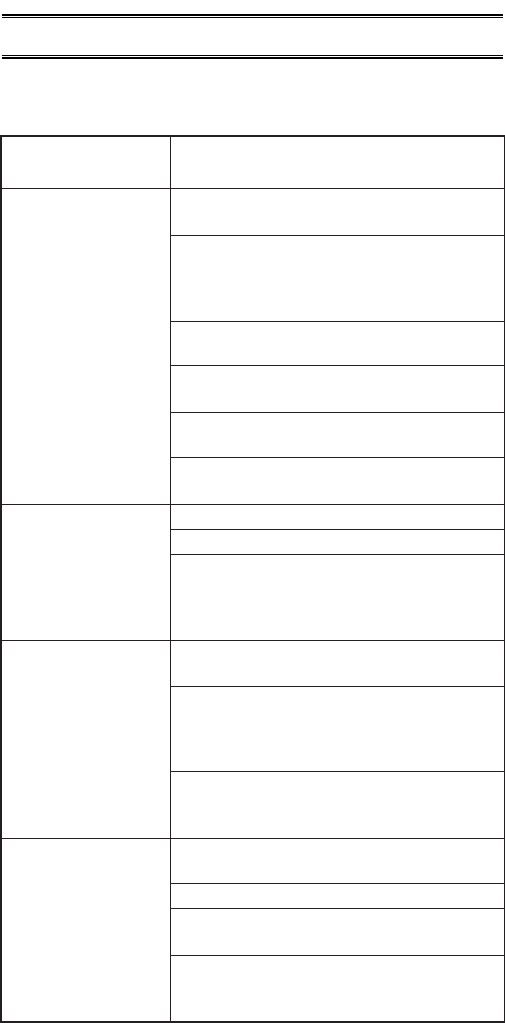
30
Troubleshooting
If your BC350C is not performing properly, try the steps listed
below.
Scanner won’t work
Improper reception
Weather scan won't
work
Scan won’t stop
•Check the connections at both ends of
the AC Adapter.
•Turn on the wall switch of your room.
You could be using an outlet controlled
by the wall switch. Move the AC
Adapter to another wall outlet.
•Check the connections at both ends of
the DC cord or cigarette lighter cord.
•Check to see if the fuse is blown.
If the fuse is blown.
•Make sure the ignition key in your
vehicle is at the Accessory position.
* Make sure the power switch is turned
on.
•Check the antenna and its connection.
•Move the scanner.
•You may be in a fringe area. This may
require an optional multi-band antenna.
Check with your dealer or local
electronics store.
•Adjust the Squelch Control, 2. Check
the Antenna Connection.
•Check to see if many of the channels
are loced out. If so. the scanner has
less chanse of finding an active
channelsl.
•Review each channel's frequency to
see if it is still stored in memory and is
correct.
•Check and adjust Squelch
(see "Adjusting the Squelch").
•Check the antenna connection.
•Check to see if all channels are locked
out.
•It is possible that none of the
programmed frequencies are active at
the time. Try the band search.
PROBLEM SOLUTION
* Applies to mobile installation only
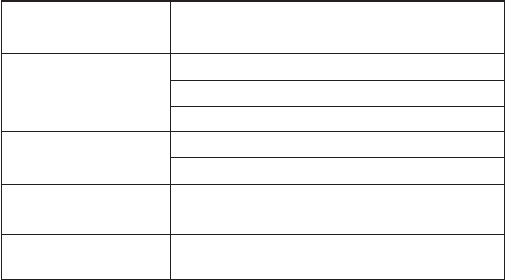
31
Scan won’t start.
Search won’t start.
PROGRAM key
won’t work.
If you still have a
problem.
•Press the bank key again.
•Adjust the Squelch Control.
•For the PRIVATE bank scan
•Adjust the Squelch Control.
•Check the antenna connection.
•Scan or search must first be stopped.
•Programming lock is ON.
•Call our customer hotline at
1-800-297-1023.
PROBLEM SOLUTION
* Applies to mobile installation only

32
Technical Specifications
Banks: Total 7 banks: 6 Service banks and
1 Private bank.
POLICE: 739 programmed plus 30
programmable channels
FIRE/EMS: 197 programmed plus 20
programmable channels
AIR: 1,160 programmed.
(All aircraft)
MRN: 90 Programmed. (All Marine)
WX: 7 programmed.
(All NOAA weather service)
CB: XXX programmed.
PRIVATE: 50 channels fully user
programmable
(Total 100 programmable channels)
Search Band: Total 13 Search bands:
(All FM except aircraft band)
Band Frequency Coverage Steps
25 – 28 25.0000 to 27.9950 MHz 5 kHz
28 – 30 28.0000 to 29.7000 MHz 5 kHz
30 – 50 30.0000 to 49.9950 MHz 5 kHz
50 – 54 50.0000 to 54.0000 MHz 5 kHz
108 – 137 108.0000 to 136.9875 MHz 12.5 kHz
137 – 144 137.0000 to 143.9950 MHz 5 kHz
144 – 148 144.0000 to 147.9950 MHz 5 kHz
148 – 174 148.0000 to 174.0000 MHz 5 kHz
406 – 420 406.0000 to 419.9875 MHz 12.5 kHz
420 – 450 420.0000 to 449.9875 MHz 12.5 kHz
450 – 470 450.0000 to 469.9875 MHz 12.5 kHz
470 – 512 470.0000 to 512.0000 MHz 12.5 kHz
806 – 956 806.0000 to 823.9875 MHz 12.5 kHz
849.0125 to 868.9875 MHz
894.0125 to 956.0000 MHz
Sensitivity: 12 dB SINAD.
(Nominal)
0.5uV 25.000 - 54.000MHz
0.4uV 137.000 - 174.000MHz
0.3uV 406.000 - 512.000MHz
0.6uV 108.000 - 136.9875MHz

33
Scan Rate: Up to 100 channels per second.
Scan Delay: 2 seconds
Audio Output: Max 3W
Antenna: 50 ohms (Impedance)
Operating Temperature: – 20ºC (– 4ºF) to + 60ºC (+ 140ºF)
Size: 5-1/5"(W) x 6-15/16"(D) x 1-5/8"(H)
Weight: 1 lb 11oz.
Certified in accordance with FCC Rules and Regulations Part
15 Sub-part C as of date of manufacture.
Features, specifications, and availability of optional
accessories are all subject to change without notice.

34
One Year Limited Warranty
Important: Evidence of original purchase is required for
warranty service.
WARRANTOR: UNIDEN AMERICA CORPORATION ("Uniden")
ELEMENTS OF WARRANTY: Uniden warrants, for one year, to the
original retail owner, this Uniden Product to be free from defects in
materials and craftsmanship with only the limitations or exclusions set
out below.
WARRANTY DURATION: This warranty to the original user shall
terminate and be of no further effect 12 months after the date of
original retail sale. The warranty is invalid if the Product is (A)
damaged or not maintained as reasonable or necessary, (B) modified,
altered, or used as part of any conversion kits, subassemblies, or any
configurations not sold by Uniden, (C) improperly installed, (D)
serviced or repaired by someone other than an authorized Uniden
service center for a defect or malfunction covered by this warranty,
(E) used in any conjunction with equipment or parts or as part of any
system not manufactured by Uniden, or (F) installed or programmed
by anyone other than as detailed by the owner’s manual for this
product.
STATEMENT OF REMEDY: In the event that the product does not
conform to this warranty at any time while this warranty is in effect,
warrantor will either, at its option, repair or replace the defective unit
and return it to you without charge for parts, service, or any other cost
(except shipping and handling) incurred by warrantor or its
representatives in connection with the performance of this warranty.
Warrantor, at its option, may replace the unit with a new or
refurbished unit. THE LIMITED WARRANTY SET FORTH ABOVE IS
THE SOLE AND ENTIRE WARRANTY PERTAINING TO THE
PRODUCT AND IS IN LIEU OF AND EXCLUDES ALL OTHER
WARRANTIES OF ANY NATURE WHATSOEVER, WHETHER
EXPRESS, IMPLIED OR ARISING BY OPERATION OF LAW,
INCLUDING, BUT NOT LIMITED TO ANY IMPLIED WARRANTIES
OF MERCHANTABILITY OR FITNESS FOR A PARTICULAR
PURPOSE. THIS WARRANTY DOES NOT COVER OR PROVIDE
FOR THE REIMBURSEMENT OR PAYMENT OF INCIDENTAL OR
CONSEQUENTIAL DAMAGES. Some states do not allow this
exclusion or limitation of incidental or consequential damages so the
above limitation or exclusion may not apply to you.
LEGAL REMEDIES: This warranty gives you specific legal rights, and
you may also have other rights which vary from state to state. This
warranty is void outside the United States of America and Canada.
PROCEDURE FOR OBTAINING PERFORMANCE OF WARRANTY:
If, after following the instructions in the owner’s manual you are
certain that the Product is defective, pack the Product carefully
(preferably in its original packaging). The Product should include all
parts and accessories originally packaged with the Product. Include
evidence of original purchase and a note describing the defect that
has caused you to return it. The Product should be shipped freight
prepaid, by traceable means, to warrantor at:
Uniden America Corporation
Parts and Service Division
4700 Amon Carter Blvd.
Fort Worth, TX 76155
(800) 297-1023, 8 a.m. to 5 p.m. CST, Monday through Friday